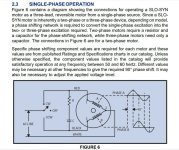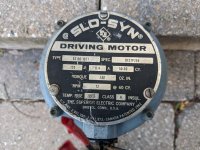www.recumbents.com
10 kW
I have an ancient (1967!) Slo-Syn SS150-1077 driving motor that I bought about 25 years ago to use as a generator motor. It's rated at 120V and .4 A. It's rated at 72RPM so it's got gears in there somewhere. It should be easy to add some bike cranks and drive it via chain with very little gear ratio change. It requires a cap and a resistor to run it from 120VAC. I'd like to use it as a pedal powered generator and am hoping that the brain trust here will be able to help me do that or tell me that it's not a good idea.
Here's the schematic for AC operation:

I'd like to use it to charge a 24V battery. That can then be used by an old APC UPS to run 120V things.
- Can the same cap and resistor be used to align both phases of the motor when used as a generator?
- Can the resulting output be run through a full rectifier diode array and then through a DC-DC convertor to reduce the voltage to around 24 VDC?
- Do I need to use one of those solar charging things to make sure that it only charges the battery and doesn't discharge it or can I do that another way?
According to this page: https://www.ahs-antriebstechnik.de/images/PDFDateien/Service/C4001-SS-Obsolete.pdf
The resistor and capacitor values are 250 ohm, 25 watt and 3.75 ufd, 330V.
https://www.mouser.com/ProductDetail/Vishay-Dale/RH025250R0FE02?qs=sGAEpiMZZMukHu%252BjC5l7YWZuL2P47FOvVS39wZKNMBk%3D
https://www.mouser.com/ProductDetail/Cornell-Dubilier-CDE/23FD3304A-F?qs=rVFmcZtbgVjhD%252BUdpF%252BkjQ%3D%3D
Thanks!
Warren
Here's the schematic for AC operation:

I'd like to use it to charge a 24V battery. That can then be used by an old APC UPS to run 120V things.
- Can the same cap and resistor be used to align both phases of the motor when used as a generator?
- Can the resulting output be run through a full rectifier diode array and then through a DC-DC convertor to reduce the voltage to around 24 VDC?
- Do I need to use one of those solar charging things to make sure that it only charges the battery and doesn't discharge it or can I do that another way?
According to this page: https://www.ahs-antriebstechnik.de/images/PDFDateien/Service/C4001-SS-Obsolete.pdf
The resistor and capacitor values are 250 ohm, 25 watt and 3.75 ufd, 330V.
https://www.mouser.com/ProductDetail/Vishay-Dale/RH025250R0FE02?qs=sGAEpiMZZMukHu%252BjC5l7YWZuL2P47FOvVS39wZKNMBk%3D
https://www.mouser.com/ProductDetail/Cornell-Dubilier-CDE/23FD3304A-F?qs=rVFmcZtbgVjhD%252BUdpF%252BkjQ%3D%3D
Thanks!
Warren


